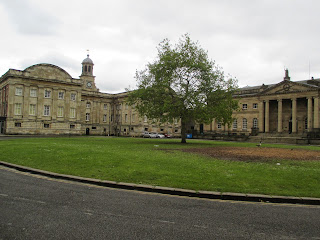
This morning we traveled to York where we would visit York Minster and York Castle Museum, while also having free time to explore the city.
York Minster, the cathedral of York, England, is one of the largest of its kind in Northern Europe. The minster is the seat of the Archbishop of York, the second-highest office of the Church of England, and is the cathedral for the Diocese of York.
York Minster is the second largest Gothic cathedral of Northern Europe and clearly charts the development of English Gothic architecture from Early English through to the Perpendicular Period. The present building was begun in about 1230 and completed in 1472.
York Minster is home to The Astronomical Clock, a memorial to the men of the Royal Air Forces of the Commonwealth and their Allies who operating from bases in Yorkshire, Durham, and Northumberland, gave their lives for us in the second World War.
Our next stop was to York Castle Museum. The York Castle Museum was founded by Dr John Kirk, a doctor from Pickering, North Yorkshire, and houses his extraordinary collection of social history, reflecting everyday life in the county. One of its renowned displays is the reconstructed street, Kirkgate, that has been hugely influential in museum displays worldwide. The York Castle Museum is housed in a former debtors’ prison and an adjoining former women’s prison.
The museum’s name comes from the fact it stands on the site of the former York Castle.
The museum’s name comes from the fact it stands on the site of the former York Castle.
Gilligans Galloping Carousel: This carousel was made in Yorkshire around 1905. Lawrence Gilligan and his horse-drawn carousel were well known on the streets of York for forty years. Children paid for a turn with glass jars and rags if they had no money. This carousel was hand cranked by Mr. Gilligan and his wife Hilda.
The hearse was bought in 1908 by the Parish of Burneston, near Bedale, North Yorkshire. During the nineteenth and early twentieth centuries country Parishes often bought a bier or small hearse that could be pulled by hand or by a pony.
This hearse was pulled by hand if the funeral was for a person who lived in the village. A pony was used for the other villages in the Parish which were between one to four miles away.
The photo to the left is of the street, Kirkgate, in the Castle Museum. Kirkgate is modeled after a typical street in the Victorian times. The street is to exemplify the life of the rich and the poor through the use of back streets, authentic York businesses, and thousands more goods on display.
After the museum we had time to explore the city in small groups. Professor Wolfe treated us all to a traditional meal of Yorkshire Pudding.








No comments:
Post a Comment